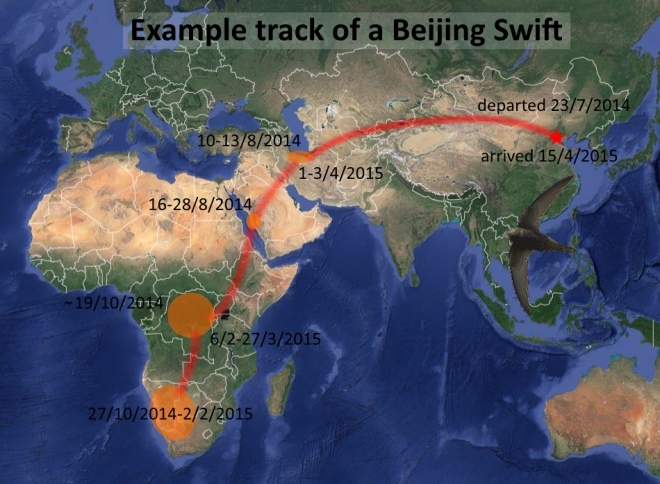 En espècies migrants és típic observar (en captivitat) un comportament anomenat “zugunruhe” que consisteix en saltar, aletejar, volar... sent especialment notori en migrants nocturns com el Bitxac comú (Saxicola torquata), ja que l’ocell no para quiet durant la nit, quan hauria d’estar descansant. Aquest comportament es realitza durant l’època de migració i dura més o menys el temps que duraria el viatge si l’ocell estigués en llibertat i pogués migrar. Per tant, es pensava exclusiu d’espècies migrants, i les poques vegades que s’observava en espècies residents es pensava que es tractava de comportaments d’aclimatació a la captivitat o provocats per factors externs.
En espècies migrants és típic observar (en captivitat) un comportament anomenat “zugunruhe” que consisteix en saltar, aletejar, volar... sent especialment notori en migrants nocturns com el Bitxac comú (Saxicola torquata), ja que l’ocell no para quiet durant la nit, quan hauria d’estar descansant. Aquest comportament es realitza durant l’època de migració i dura més o menys el temps que duraria el viatge si l’ocell estigués en llibertat i pogués migrar. Per tant, es pensava exclusiu d’espècies migrants, i les poques vegades que s’observava en espècies residents es pensava que es tractava de comportaments d’aclimatació a la captivitat o provocats per factors externs.Barbara Helm i Eberhard Gwinner van estudiar en condicions de laboratori el “zugunruhe” en dues subspècies de bitxac, la migrant de casa nostra (S. t. rubicola), i una de resident africana (S. t. axillaris). Van trobar que tot i que el comportament és menys intens en la subspècie resident, es realitza en les mateixes dates, te característiques semblants, i és clarament endogen. Per tant, el “zugunruhe” pot estar estès tant entre espècies migrants com no migrants, obrint noves portes a l’estudi de l’evolució de la migració, i a explicar els mecanismes pròxims de certs tipus de dispersió.
> Helm, B. I Gwinner, E. 2006. Migratory restlessness in an equatorial nonmigratory bird. PloS Biology 4: e110
Photo by Jose Sousa (Flickr; Creative Commons)
---------------------------- ESPAÑOL ----------------------------------
Zugunruhe: ganas de migrar
 En especias migradoras, es típico observar (en cautividad) un comportamiento denominado "zugunruhe" que consiste en saltar, aletear, volar... siendo especialmente notorio en migrantes nocturnos como la tarabilla común (Saxicola torquata), ya que el pájaro no está quieto durante la noche, cuando tendría que estar descansando. Este comportamiento se realiza durante la época de migración y dura más o menos el tiempo que duraría el viaje si el pájaro estuviera en libertad y pudiera migrar. Por lo tanto, se pensaba, era exclusivo de especias migrantes, y las pocas veces que se observaba en especies residentes se creía que se trataba de comportamientos de aclimatación a la cautividad o provocados por factores externos.
En especias migradoras, es típico observar (en cautividad) un comportamiento denominado "zugunruhe" que consiste en saltar, aletear, volar... siendo especialmente notorio en migrantes nocturnos como la tarabilla común (Saxicola torquata), ya que el pájaro no está quieto durante la noche, cuando tendría que estar descansando. Este comportamiento se realiza durante la época de migración y dura más o menos el tiempo que duraría el viaje si el pájaro estuviera en libertad y pudiera migrar. Por lo tanto, se pensaba, era exclusivo de especias migrantes, y las pocas veces que se observaba en especies residentes se creía que se trataba de comportamientos de aclimatación a la cautividad o provocados por factores externos.Barbara Helm y Eberhard Gwinner estudiaron en condiciones de laboratorio, el "zugunruhe" en dos subespecies de tarabilla, S. t. rubicola y una subespecie residente africana (S. t. axillaris). Encontraron que, aunque el comportamiento es menos intenso en la subespecie residente, se realiza en las mismas fechas, tiene características parecidas, y es claramente endógeno. Por lo tanto, el "zugunruhe" puede estar extendido tanto entre especies migrantes como no migrantes, abriendo nuevas puertas al estudio de la evolución de la migración, así como a explicar los mecanismos próximos de ciertos tipos de dispersión.
> Helm, B. I Gwinner, E. 2006. Migratory restlessness in an equatorial nonmigratory bird. PloS Biology 4: e110 Photo by Jose Sousa (Flickr; Creative Commons)











.jpg)
0 comentarios:
Post a Comment